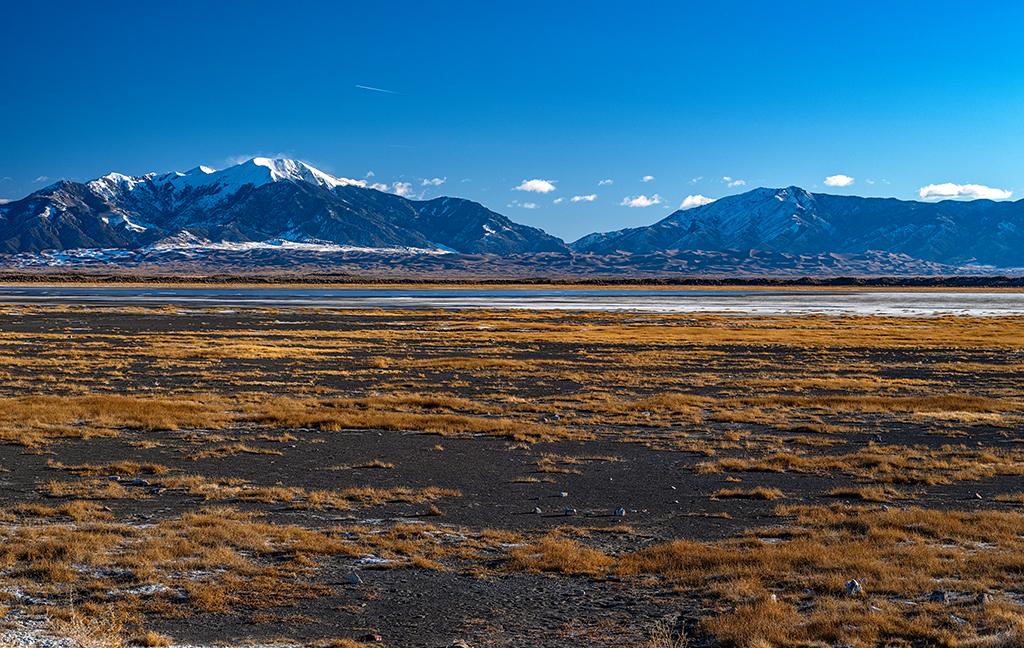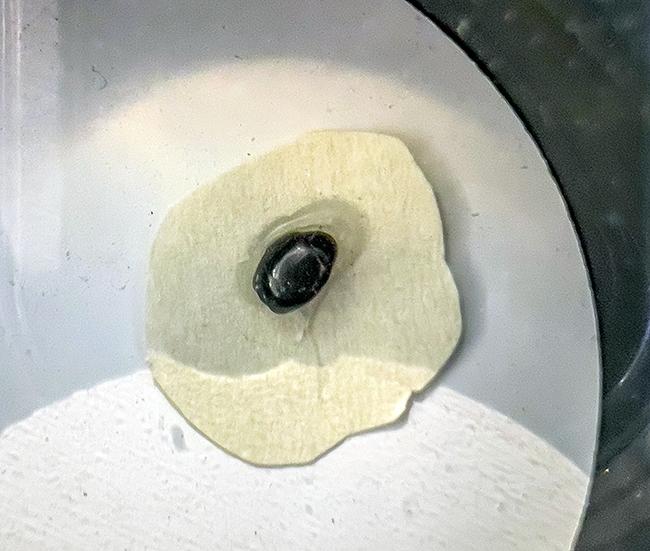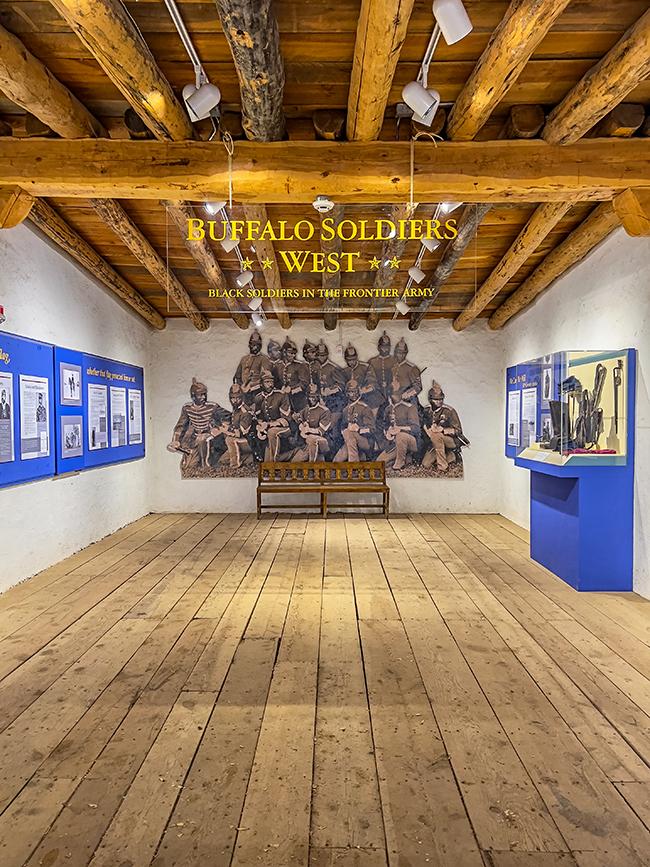I spy with my little eye: a couple of people (lower right center) heading toward the dunes, Great Sand Dunes National Park and Preserve / Rebecca Latson
If you look at a Google Maps or Google Earth view of Great Sand Dunes National Park and Preserve in Colorado, you might think “gee, those sand dunes don’t look so large.” With an area of about 150,000 acres (604 km2), this unit of the National Park System isn’t as large a park as Yellowstone (2,221,766 acres / 8,991 km2) or Yosemite (748,542 acres / 3,029 km2) national parks, but when you stand before the largest sand dunes in North America, this national park sure feels large.
This month’s quiz and trivia piece focuses on Great Sand Dunes National Park and Preserve. How many of you have visited? Test your Great Sand Dunes knowledge with these 10 questions, then read a little trivia about the park. You might learn something new in the process.
1. True or False: the Great Sand Dunes have been dated to be about 15 million years old.
a) True
b) False
2. True or False: as you hike the dunes in this national park, you’ll need to watch your step for quicksand, especially around Star Dune.
a) True
b) False

A view of Great Sand Dunes National Park from San Luis State Wildlife Area / Rebecca Latson
3. The large dunefield is just one of four primary components of the Great Sand Dunes geological system: mountain watershed, dunefield, sand sheet, and ___ are each important aspects of this complex sand system.
a) Sabkha
b) Berm
c) Wetlands
d) Grasslands
4. The active dunefield in Great Sand Dunes National Park measures ___ square miles.
a) 10
b) 20
c) 30
d) 40
5. The dunefield is composed of reversing dunes, barchan dunes, star dunes, and ___ dunes.
a) Parabalic
b) Nebkha
c) Transverse
d) Subalpine

Sunrise over the mountains, Great Sand Dunes National Park and Preserve / Rebecca Latson
6. The Great Sand Dunes are located within the broad San Luis Valley, which is surrounded by the ___ Mountains to the east, and the San Juan Mountains to the west.
a) La Sal
b) Sangre de Cristo
c) San Isabel
d) San Francisco
7. Sand is everywhere at Great Sand Dunes National Park, and not confined only to the dunes. As a matter of fact, the dunes make up only ___ percent of the 330 square-mile deposit of sand (that’s sand everywhere in this national park, and not just the dunefield)..
a) 10
b) 11
c) 12
d) 13

Sandsheet, sand dunes, and mountains, Great Sand Dunes National Park and Preserve / Rebecca Latson
8. True or False: of the primary components of the Great Sand Dunes geological system, the sandsheet is the largest component.
a) True
b) False
9. Many of the species of insects found within the Great Sand Dunes environment are known as ___.
a) Sand obligates
b) Dune dwellers
c) Sand adapters
d) Sand binders

A teeny, weeny, pea-sized clown beetle, Great Sand Dunes National Park and Preserve / Rebecca Latson
10. One endemic insect species you might see at this national park is the clown beetle. Clown beetles are also known as ___.
a) Hister beetles
b) Ball beetles
c) Silly beetles
d) Globe beetles
Trivia

A part of the Colorado route of the Old Spanish Trail, Old Spanish National Historic Trail / Rebecca Latson
“Established by Congress in 2002 as America’s 15th national historic trail, the Old Spanish [National Historic] Trail route spans six western states, including many locations accessible to the public. At Great Sand Dunes National Park, State Highway 150 and County Lane 6 on the southern border of the park follow or cross some of the Old Spanish Trail routes. Because of sandy, shifting soils, no traces of the trail are visible on the ground near the park today. However, traces of some of the trail’s seasonally varied routes through the valley have been observed from the air. Historical and visual evidence indicates one route passing by Indian Spring, through what is now part of Great Sand Dunes National Park.” To learn more about the Old Spanish Trail through Great Sand Dunes, click here.

One of the Buffalo Soldiers exhibits at Fort Garland Museum & Cultural Center / Rebecca Latson
“African American Buffalo Soldiers patrolled the Great Sand Dunes region from 1876-1879, courageously working to protect both settlers and tribes during a volatile era. Though they faced prejudice and poor treatment from some, Buffalo Soldiers overall served their country with honor and bravery, and were awarded more Medals of Honor than any other American military unit during that era.”
Based at nearby Fort Garland, the 9th Cavalry Buffalo Soldiers patrolled the Great Sand Dunes region in the 1870s, protecting both settlers and tribes. Western tribes honored them with the name ‘Buffalo Soldiers’. To North American Indigenous peoples, bison are strong and majestic, enduring blizzards, heat and drought. Buffalo Soldiers recognized the positive intention of this unique name, which stayed with these units as long as segregation lasted in the military.
You can learn more about the Buffalo Soldiers by visiting Fort Garland Museum, approximately 27 miles south of Great Sand Dunes National Park.

Capturing black magnetite grains in the sand dunes, Great Sand Dunes National Park and Preserve / Rebecca Latson
What exactly are you looking at with this series of three photos? Well, the sand dunes in Great Sand Dunes National Park are magnetic! As you hike the dunes, you might see black stripes or patches on the sand. You are looking at black grains of the mineral magnetite, which, appropriately enough, has magnetic properties. If you place a magnet on the sand (the Visitor Center has a wide array of magnets), then pick the magnet up and turn it over, you’ll see clumps of little black magnetite grains picked up by the magnet.
Quiz Answers
1b False
According to the National Park Service, “To date there is no accurate process to date sand. Optically Stimulated Luminescence (OSL) dating may provide us with some clues, but so far the results at Great Sand Dunes are inconclusive. The OSL process determines how much time has passed since quartz crystals were last exposed to sunlight.” Currently, it’s believed the sand dunes are around 400,000 years old.
2b False
Not only can you play in one of the largest “sandboxes” in North America, but you don’t need to worry about scorpions or venomous snakes, as “there are no scorpions, venomous snakes, or quicksand on the dunes or anywhere in this high elevation park.” You do, however, need to be mindful of any oncoming storms, since lightning “will often strike the dunefield.”
3a
The large dunefield is just one of four primary components of the Great Sand Dunes geological system: mountain watershed, dunefield, sand sheet, and sabkha. A sabkha is a flat coastal plain with a salt crust. You can get a great view of these four components while visiting the San Luis State Wildlife Area on Lane 6 N, halfway between the community of Mosca and the turnoff onto Colorado State Highway 150.
4c
The active dunefield in Great Sand Dunes National Park measures 30 square miles (78 km2).
5c
According to the National Park Service, the dunefield is composed of reversing dunes, barchan dunes, star dunes, and transverse dunes. To learn about each of these dunes, click here.
6b
The Great Sand Dunes are located within the San Luis Valley, which is surrounded by the Sangre de Cristo Mountains to the east, and the San Juan Mountains to the west. According to Britannica.com, these mountains were named “in 1719 by the Spanish explorer Antonio Valverde y Cosio, who, impressed at sunrise by the red-tinted snowy peaks, supposedly uttered a fervent ‘Sangre de Cristo (Blood of Christ)’.”
7b
According to the National Park Service, “These huge dunes … are about 11 percent of a 330-square-mile deposit of sand.
8a True
The largest component of the Great Sand Dunes geological system is the sandsheet, made up of sandy grasslands that extend around three sides of the main dunefield. The sand sheet is the primary source of sand for the Great Sand Dunes.
9a
According to the National Park Service, “many of the insects here are ‘sand obligates‘, meaning that they are adapted uniquely for sandy habitats such as the dunefield. Currently, just over 1,000 different kinds of arthropods (insects and spiders) are known to live at the Great Sand Dunes. However, this may represent only about 25% of the total number of arthropods that may exist here.”
10a
“Tiny, shining black, and globe-shaped, clown beetles (also known as hister beetles) may be found in grassy areas of the dunes, or even near the tops of the highest dunes. The adults are scavengers, while the larvae (caterpillars) are predatory, probably preying on weevils (Curculionidae), scarab beetles (Scarab-aeidae), and fly larvae that they find feeding on decaying grasses and other non-woody plants. With their round bodies, clown beetles can roll along with the wind to a new location. They may also flip over when held in your hand.





